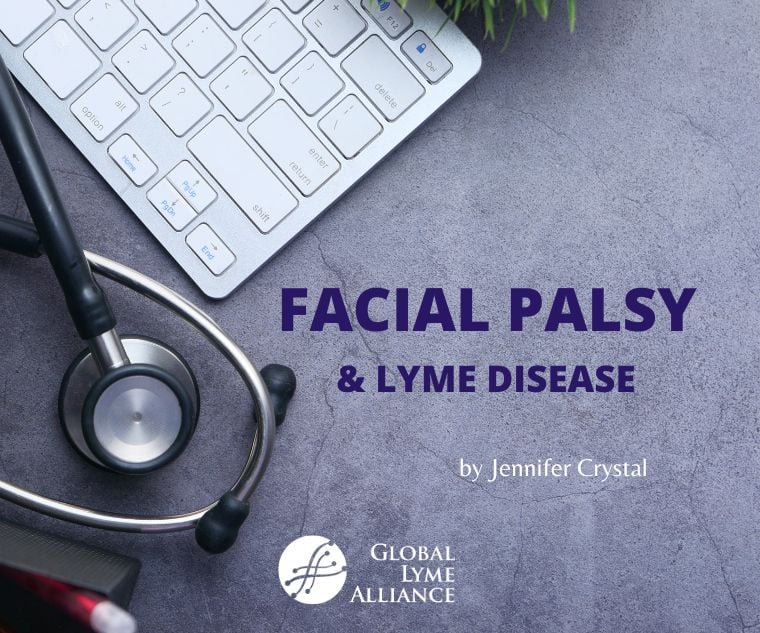
Learn about the connection between Lyme disease and facial palsy, a symptom of neurological Lyme disease. Discover the importance of early diagnosis and treatment to avoid long-term complications.
Since I was three months old, I have had a condition called strabismus, in which my eyes don’t look in the same direction at the same time. Sometimes referred to as “lazy eye”, one eye might float up and in while the other stays centered. After four corrective surgeries, my eyes now work together when I’m wearing contact lenses, and no one notices the strabismus.
Following my final eye surgery during my senior year of college, however, people did start to notice a change in my face. “Why are your eyes two different sizes?” they asked. Indeed, my left eye suddenly looked markedly smaller than the right, with the left lid noticeably drooping. My surgeon thought the muscles around my eyes may have been affected by the surgery, causing the change in shape and the lid droop.
And while that very well may have been the case, there also may have been another cause that none of us knew to consider at the time: I had been suffering for three years with undiagnosed tick-borne illnesses Lyme disease, babesiosis, and ehrlichiosis. Lyme disease bacteria, I later learned, tend to congregate in scar tissue, compromising healing. It’s possible that Lyme bacteria around my eye caused my body to recover differently than it had from the surgeries I’d had before I was bitten by a tick.
It's also possible that I had a symptom of Lyme disease called facial palsy, which is muscle weakness that can cause one or both sides of the face to droop. Different from Bell’s palsy, which only causes one side of the face to droop, Lyme-related facial palsy can affect one or both eyes, eyelids, or other parts of the face. It might cause an uneven smile; the asymmetry can be pronounced for some people, but more subtle for others. Facial palsy can also cause ear pain or changes in taste.
Had we considered my eyelid droop to be part of facial palsy, we might have gotten to my Lyme disease diagnosis several years sooner. Instead, it would be another five years after that eye surgery until I was accurately diagnosed. There were so many clues that were missed along the way—joint aches, migraine headaches, burning extremities, hives, waxing and waning extreme fatigue.
Stay Connected, Make an Impact
Join our community of advocates by subscribing to our newsletter—stay informed with the latest breakthroughs in Lyme disease research and news. Ready to take the next step? Your donation to Global Lyme Alliance fuels the fight for a cure.
Subscribe Now to stay involved, or Donate Today to help us overcome Lyme disease.
It's important to consider all tick-borne illnesses when associated symptoms can’t otherwise be explained. This is especially true with facial palsy, which is a serious symptom of neurological Lyme disease that warrants immediate antibiotic treatment. According to Mass Eye and Ear, about 5% of people with Lyme disease will develop facial palsy, usually seven to 21 days after a tick bite[i]. If you don’t know if or when you had a tick bite and you develop facial palsy, your doctor might assume it’s Bell’s palsy. It’s important to ask if it could instead be facial palsy, because there are some key differences between the two:
- Bell’s palsy usually only affects one side of the face, while facial palsy can affect both.
- Bell’s palsy is believed to be caused by a virus and is therefore treated with corticosteroids and antivirals. Treating Lyme disease, which is a bacterial infection, as Bell’s palsy can result in long-term complications. Lyme-associated Bell’s palsy, caused by a bacterium, must be treated with antibiotics.
- Patients with Bell’s palsy usually are not otherwise sick, while patients with Lyme disease usually have other symptoms of Lyme along with facial palsy.i
Recovery from Lyme-associated facial palsy can take months, with appropriate treatment. Also according to Mass Eye and Ear, some people with Lyme-associated facial palsy can develop permanent facial muscle tightness, involuntary facial movements, or restricted smile.
My own eyes are still two different sizes, though they’re better than they were when people first started to notice the asymmetry, and my lid only droops when I’m especially tired. I won’t ever know if my symptoms were related to Lyme or to my strabismus surgery. I know for sure that had I not been accurately diagnosed with and adequately treated for tick-borne illnesses, I would not be living the full life I am today. If you suspect you have symptoms of tick-borne illness, or had a known tick bite, see a Lyme Literate Medical Doctor.
[i] https://focus.masseyeandear.org/lyme-disease-and-facial-weakness-what-you-should-know/
***

Jennifer Crystal
Writer
Opinions expressed by contributors are their own. Jennifer Crystal is a writer and educator in Boston. Her work has appeared in local and national publications including Harvard Health Publishing and The Boston Globe. As a GLA columnist for over six years, her work on GLA.org has received mention in publications such as The New Yorker, weatherchannel.com, CQ Researcher, and ProHealth.com. Jennifer is a patient advocate who has dealt with chronic illness, including Lyme and other tick-borne infections. Her memoir, One Tick Stopped the Clock, was published by Legacy Book Press in 2024. Ten percent of proceeds from the book will go to Global Lyme Alliance. Contact her via email below.







-2.jpg)